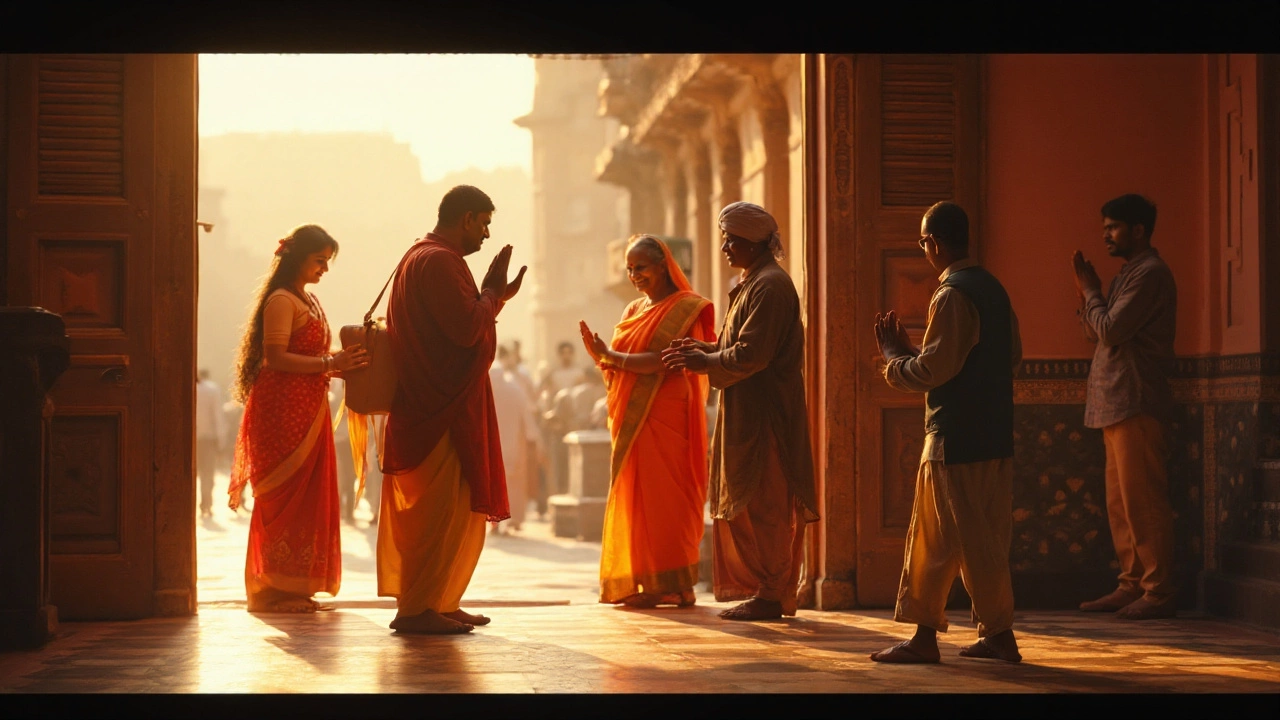
You clicked in to settle a simple question: what should you say so you’re polite, appropriate, and not awkward in India? Here’s the short truth-there isn’t one single “best” word for every lane, language, and room. But there is a safe, respectful default and a few easy swaps that cover 95% of real-life situations. Expect a clear answer up front, practical steps, real examples by region, a quick cheat sheet, and fixes for common mistakes.
The Short Answer: What to Say, When, and Why
Indian greeting norms are friendly and flexible. If you remember one line and one gesture, you’re set.
- TL;DR: Say “Namaste” (nah-muh-stay) with palms together at chest level and a small nod. It’s the most widely understood, respectful, contactless greeting across India-in homes, offices, and public spaces.
- When to prefer “Namaskar”: choose this in formal settings, with elders, or in business if you want a more polished tone. It’s a Sanskrit-based equivalent of Namaste and works pan-India.
- Regional swaps that win hearts: “Vanakkam” (Tamil Nadu), “Namaskaram” (Telugu/Kannada/Malayalam), “Nomoskar” (Bengal), “Sat Sri Akal” (Sikh contexts), “Assalamualaikum” (Muslim contexts), “Ram Ram” (north Indian rural/cultural contexts). Use these if you know the audience or they greet you first this way.
- Handshakes: fine in urban business. Keep it light; don’t assume. If someone hesitates, switch to the Namaste gesture instantly. WHO (2020) nudged people toward contactless greetings, and many in India still prefer them in crowded settings.
- English still works: “Hello” or “Good morning” is normal in offices, hotels, and most urban shops. Add the Namaste gesture for extra warmth.
- Pronunciation quick wins: Na-muh-STAY; Na-mas-KAAR; Va-na-KKAM; Na-mas-KAA-rum; No-mo-SKAAR. Smile, slow down, hold eye contact briefly.
- What to avoid: religious slogans you don’t personally follow in formal or mixed company; hugging strangers; over-eager handshakes; touching feet unless you’re part of the family or invited to do so.
Why this works: “Namaste” is language-light, posture-based, and instantly understood. The Ministry of Tourism’s “Incredible India” campaigns have long leaned on the Namaste gesture to signal welcome. In metros like Mumbai, Delhi, and Bengaluru, you’ll hear English greetings all day, yet “Namaste” still lands as respectful and warm.
How to Choose the Right Greeting (Step-by-Step)
Use this simple flow the moment you’re about to greet someone. It takes three seconds in your head.
- Read the room. Is it formal (office, meeting, ceremony), casual (friends, cafe), or sacred (temple, gurudwara, dargah)? Formal and sacred lean traditional; casual is wide open.
- Sense the region/language. If you’re in Tamil Nadu, “Vanakkam” wins. In Andhra/Telangana or Kerala or Karnataka, “Namaskaram” is safe. In West Bengal, “Nomoskar.” If you’re unsure or traveling across states, “Namaste” covers you.
- Pick the phrase. Defaults: “Namaste” or “Hello.” Formal upgrade: “Namaskar.” Regional charm: local greeting if you know it.
- Add the gesture. Palms together (called “añjali mudra”), thumbs lightly touching your chest, small head bow. Keep elbows relaxed. Hold for a second, then release.
- Mind the voice. Warm, medium volume, clean enunciation. If the other person greets softly, mirror that softness.
- Decide on touch. Do not assume a handshake. If the other person extends a hand, match it with a light, brief shake. If they don’t, the Namaste gesture is more than enough.
- Choose the address form. Add “ji” for respect in north/central India: “Namaste, Gupta-ji.” In Hindi or Urdu, use “aap” (formal you) with elders and strangers. With peers in casual settings, “hello” or a first name is fine.
- Time-of-day helps but isn’t required. “Good morning/afternoon/evening” pairs well with the Namaste gesture in business. In local languages, time-based greetings are less common than in English.
- On text or email. Start with “Namaste,” “Hello,” or “Hi” depending on tone. In formal emails, “Namaste” or “Dear [Name]” both work. On WhatsApp with new contacts, “Namaste” or “Hello” reads polite and neutral.
That’s the whole playbook. If you freeze, just smile, do the Namaste gesture, and say “Namaste.” You won’t go wrong.

Real-World Examples and Regional Phrases
Here’s how this plays out in daily life. I live in Mumbai-on a suburban train at 8:30 a.m., you’ll hear “Good morning” at offices and “Namaste, aunty” in the same breath. Context runs the show.
Business meeting (Mumbai, Bengaluru, Delhi)
- You: “Good morning. Namaste.” (gesture) If a handshake is offered, respond lightly.
- They: “Good morning.” You: “Pleasure to meet you.” Keep it simple.
Temple visit (any state)
- You to priest or staff: “Namaste.” (gesture) Or use local: “Namaskaram” in the south, “Nomoskar” in Bengal.
- Avoid loud “Hello” in prayer spaces. Keep voice low, body language calm.
Meeting elders in a home
- You: “Namaste, aunty.” (gesture) Add “ji” for extra warmth: “Namaste, Sharma-ji.”
- If they try to bless you with a light touch on your head, accept with a smile.
College campus or with friends
- You: “Hey,” “Hi,” “Hello,” or “Namaste”-all normal. If you want to be cute-local: “Vanakkam” in Chennai, “Namaskara” in Bengaluru, “Kemon achho?” in Kolkata followed by “Nomoskar” to elders.
Hotel check-in or customer service
- Staff: “Namaste. Welcome.” You: “Namaste.” The gesture is common in hospitality; it signals care.
Weddings, ceremonies
- You: “Namaste” to elders and hosts. In a Sikh wedding, “Sat Sri Akal” is perfect. In a Muslim nikah, “Assalamualaikum” is warmly received; reply is “Wa alaikum assalam.”
Somber occasions
- Keep it soft: “Namaste.” Pair with “I’m so sorry for your loss.” Avoid cheerful time-of-day greetings.
On email
- Formal: “Namaste [Name],” or “Dear [Name],”
- Neutral: “Hello [Name],”
- Close colleagues: “Hi [Name],”
On WhatsApp
- New contact: “Namaste, this is [Your Name] from [Company]. May I call now?”
- Known contact: “Hi [Name], got a minute?”
Regional greetings that make locals smile:
- Tamil Nadu: “Vanakkam.”
- Kerala: “Namaskaram” (Malayalam: “Namaskaaram”).
- Karnataka: “Namaskara.”
- Andhra Pradesh/Telangana: “Namaskaram.”
- West Bengal: “Nomoskar.”
- Maharashtra: “Namaskar” or “Namaste.”
- Punjab: “Sat Sri Akal.”
- Uttar Pradesh, Rajasthan, Haryana: “Namaste,” sometimes “Ram Ram.”
- Kashmir: “Adaab” in some contexts, “Namaste” widely understood.
- Assam: “Namaskar.”
Pronunciation cheat lines (say them slow, smile while you speak):
- Namaste: nah-muh-STAY
- Namaskar/Namaskara/Namaskaram: nah-mas-KAAR / nah-mas-KAA-rahm
- Vanakkam: vah-nuh-KKUM (double “k” sound)
- Nomoskar: noh-moh-SKAAR
- Sat Sri Akal: sut sree a-kaal
- Assalamualaikum: us-sa-laam-mu-uh-lay-kum
Quick data snapshot to ground the “where” and “what.” These are rounded speaker estimates; India is multilingual, and most people understand more than one greeting.
| Region/Language | Common Greeting | Approx. Native Speakers (millions) | Notes |
|---|---|---|---|
| Hindi belt (Hindi) | Namaste / Namaskar | ~520 | Includes variants across north/central India (Census 2011; OED notes Sanskrit roots) |
| Bengal (Bengali) | Nomoskar | ~97 | “Nomoskar” mirrors Namaskar, soft “o” vowel |
| Maharashtra (Marathi) | Namaskar / Namaste | ~83 | Formal settings prefer “Namaskar” |
| Andhra/Telangana (Telugu) | Namaskaram | ~81 | Polite default in offices and homes |
| Tamil Nadu (Tamil) | Vanakkam | ~69 | Warm, iconic Tamil greeting |
| Gujarat (Gujarati) | Namaste / Namaskar | ~55 | Both forms common |
| Punjab (Punjabi) | Sat Sri Akal | ~33 | Frequent in Sikh cultural spaces |
| Kerala (Malayalam) | Namaskaram | ~34 | Soft “r” ending, gentle tone |
| Karnataka (Kannada) | Namaskara | ~44 | Used in both formal and casual settings |
| Uttar Pradesh, Haryana, Rajasthan (varied) | Namaste / Ram Ram | - | “Ram Ram” appears in rural/social contexts |
Sources for figures: Census of India 2011 language data; public dictionaries and state usage notes. Speaker counts are rounded for simplicity and everyday use.
Small cultural cues that matter:
- Eye contact: brief and kind. Staring feels rude; looking away mid-greet feels cold.
- Distance: half an arm’s length in offices; a bit more in homes unless invited closer.
- Volume: match the local vibe. Mumbai lobbies are loud; temple corridors are whisper-soft.
Quick Cheat Sheet, Pitfalls, and Mini‑FAQ
Bookmark this section in your mind. It’s the fast lane for daily interactions.
Cheat sheet
- Unsure what to say? “Namaste” + gesture.
- Need formal? “Namaskar” + gesture.
- Want to impress locally? Use the state’s greeting if you know it: “Vanakkam” (TN), “Namaskaram” (AP/Telangana/Kerala), “Nomoskar” (Bengal), “Namaskara” (Karnataka).
- Business in metros? “Good morning” plus a small Namaste nod works everywhere.
- Religious or mixed group? Avoid devotional slogans unless they use them first.
- Handshake check: offer only if they offer. If not, switch to Namaste.
Common pitfalls (and how to fix them)
- Going for a hug with strangers. Fix: Smile, step back slightly, do the Namaste gesture.
- Over-enthusiastic handshake. Fix: light, brief, one pump; or skip entirely.
- Shouting “HELLO!” in a quiet sacred space. Fix: soft “Namaste,” small nod.
- Using a devotional slogan you don’t understand. Fix: stay neutral with “Namaste.”
- Touching elders’ feet without context. Fix: wait; if someone prompts “ashirwad” (blessings), then it’s okay.
- Mispronouncing loudly. Fix: say it slow, smile. People care more about respect than perfect vowels.
Mini‑FAQ
- Is “Namaste” religious? It has Sanskrit roots and a spiritual flavor, but in modern India it functions as a secular, respectful greeting. Government tourism campaigns and schools use it in non-religious contexts.
- Namaste vs Namaskar-which is more respectful? “Namaskar” sounds a notch more formal. Use it with elders, in ceremonies, or to add polish in business. “Namaste” is fine everywhere.
- How deep should I bow? Just a small nod. Save deeper bows for ritual settings or when you’re mirroring an elder.
- Should I add “ji” after someone’s name? In north and west India, yes-“Malhotra-ji” signals respect. In the south, use honorifics like “sir/ma’am” or local equivalents; “ji” is understood but less common.
- Is a handshake okay in 2025? Yes, but optional. Many prefer the Namaste gesture, especially in health-conscious spaces. If someone offers a hand, match their pressure lightly.
- What about “Sat Sri Akal,” “Assalamualaikum,” or “Ram Ram”? Beautiful in the right spaces. Use them when you’re part of that culture or when greeted that way first. In mixed company, stick to “Namaste” or “Hello.”
- How do I respond if someone greets me with “Assalamualaikum”? Say “Wa alaikum assalam.” With “Sat Sri Akal,” respond the same phrase back. With “Namaste/Namaskar,” reply in kind.
- Any rules for kids and elders? Kids often say “Namaste, aunty/uncle.” Adults typically avoid first names with elders unless invited. Politeness beats perfect language.
- Do Indians greet with time-of-day in local languages? Less than in English. “Good morning/afternoon/evening” is common in schools and offices; “Namaste” works all day.
Next steps
- Traveling soon? Learn one local line before you land. TN: “Vanakkam.” Karnataka: “Namaskara.” Kerala: “Namaskaram.” Bengal: “Nomoskar.”
- Business trip? Open with “Good morning” and the Namaste gesture. Adjust to their style in the first minute.
- New neighbors? “Namaste” at the door with a smile. Works every time.
Troubleshooting
- You mispronounced and feel awkward. Laugh lightly: “Still learning-Namaste.” People will help you.
- You offered a handshake and they didn’t take it. No stress. Shift smoothly to the Namaste gesture.
- They used a devotional greeting you don’t share. Smile, nod, reply with the same line respectfully or use “Namaste” if you’re unsure.
- Crowded or flu season. Prioritize the Namaste gesture. WHO nudged this in 2020, and many in India kept the habit in packed spaces.
- Unsure how to address someone. Add “ji” after the last name in the north/west, use “sir/ma’am” in business, or ask: “How may I address you?”
If you remember nothing else, remember this: a warm smile, the Namaste gesture, and a simple “Namaste” will never be out of place-on a Mumbai local, in a Chennai boardroom, or at a Kolkata home-cooked dinner. Add local flavor when you can; stay neutral when you can’t. That’s how you greet like you belong.